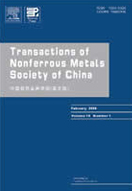Electrochemical hydrogen storage properties ofnon-equilibrium Ti2-xMgxNi alloys
(1. College of Materials Science and Engineering, Nanjing Tech University, Nanjing 210009, China;
2. State Key Laboratory of Materials-Oriented Chemical Engineering, Nanjing Tech University, Nanjing 210009, China)
2. State Key Laboratory of Materials-Oriented Chemical Engineering, Nanjing Tech University, Nanjing 210009, China)
Abstract: Amorphous Ti2-xMgxNi (x=0-0.3) alloys were prepared by mechanical milling of elemental powders. Charge and discharge test, linear polarization (LP) and potential-step measurement were carried out to investigate the electrochemical hydrogen storage properties of the alloys before and after heat treatment. The results show that the maximum discharge capacity of heat-treated Ti2-xMgxNi alloy can reach 275.3 mA·h/g, which is 100 mA·h/g higher than that of the amorphous Ti2-xMgxNi alloy. The heat-treated Ti1.9Mg0.1Ni alloy presents the best cycling stability with a high discharge capacity of 210 mA·h/g after 30 cycles. The results of LP and potential-step measurement of the Ti1.9Mg0.1Ni alloy show that the exchange current density increases from 101.1 to 203.3 mA/g and the hydrogen diffusion coefficient increases from 3.20×10-11 to 2.70×10-10 cm2/s after the heat treatment, indicating that the heat treatment facilitates both the charge-transfer and hydrogen diffusion processes, resulting in an improvement in electrochemical hydrogen storage properties of Ti2-xMgxNi (x=0-0.3) alloys.
Key words: Ti2-xMgxNi alloy; amorphous; heat treatment; exchange current density; hydrogen diffusion coefficient

